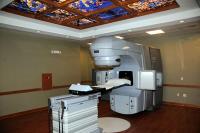- My urologist says my biopsies showed prostate cancer. What do I do now?
- Radiation Therapy is an option for treatment of my prostate cancer. How does it work?
- So what is all the excitement about Image Guided IGRT/IMRT and what is it anyway?
- What do you do with the images obtained before receiving radiation treatment each day?
- This treatment sounds interesting. But can I afford it?
- I think I am interested in IGRT. How do I get started?
- You have used the term IMRT. What does it mean?
- How do you get set up for IMRT?
- What happens when my IMRT Plan is complete?
- How is the x-ray treatment given?
- What about Image Guided Therapy (IGRT)?
My urologist says my biopsies showed prostate cancer. What do I do now?
Answer: Remain calm. A wide range of good treatment options exist for prostate cancer. Talk to your urologist about which treatment options are available for you.
Radiation Therapy is an option for treatment of my prostate cancer. How does it work?
Answer: Radiation Therapy is a time-proven treatment for cancer. Most tumors are more sensitive to radiation than the surrounding normal structures (your bladder and rectum); thus, can be effectively treated. Radiation can take several forms including radioactive seeds (gamma rays), proton beam, and man-made x-ray treatment.
So what is all the excitement about Image Guided IGRT/IMRT and what is it anyway?
Answer: Image guided radiotherapy represents one of the most significant technical advances in radiotherapy. Image guided radiotherapy shows significant promise in improving our ability to give sufficient radiation doses to sterilize tumors while protecting normal structures; thus, potentially decreasing the risk of complications.
What do you do with the images obtained before receiving radiation treatment each day?

CT Image Localization
Answer: There are two types of images which can be obtained in the treatment room. The first is similar to the initial CT scan used to create the treatment plan. The staff then uses this new image by superimposing it over the original CT image. Notations can be made of any internal organ movement and the treatment position can be adjusted to accommodate them, thus increasing the accuracy of the treatment. Increased accuracy over the seven to eight weeks of treatment can be associated with an increased potential for cure and a decreased risk of side effects and complications.
A second image, acquired on a daily basis, adjusts for organ movement. You are placed on the treatment bed in the treatment room in the usual way. However, just prior to beginning your treatment, this image is obtained to determine the relative positions of the internal organs.
This treatment sounds interesting. But can I afford it?
Answer: The treatment is a Medicare reimbursed therapy and is approved by most private insurance carriers. Coverage is generally good, although your individual plan may be subject to co-pay and/or deductible amounts. Feel free to contact our staff if you have any questions and we will do our best to assist you.
I think I am interested in IGRT. How do I get started?
Answer: The usual first step is to make an appointment for a consultation with your physician to be sure that you are a good candidate for radiation treatment. His visit is similar to those in other doctors' offices with a review of your history and a physical exam. We then review with you the procedure as well as the risks. Usually you receive no radiation at this time, although an occasional patient may receive a CT scan to begin the planning process.
You have used the term IMRT. What does it mean?
Answer: Intensity modulated radiation therapy (IMRT) is a relatively new technique to improve external delivery of radiation therapy by a linear accelerator. Instead of maintaining a uniform radiation beam as used in conventional or 3-dimensional radiation, IMRT uses devices within the machine to divide the radiation beam into multiple smaller beams called beamlets that can have different intensities (modulated) within the area being treated. This allows more precise delivery of radiation doses to the tissues within the target area, allowing increased doses to the prostate while relatively sparing the surrounding bladder and rectum. This is important as several recent medical studies have suggested that higher prostate doses are associated with increased curability.
How do you get set up for IMRT?
Answer: Several steps are required to set up your therapy. Prior to beginning your treatment, you will come to our office for imaging. Generally speaking, a CT-Scan of the pelvis is performed, although occasionally additional scans including an MRI are obtained. At the time of the CT-Scan, the staff will place you in treatment position. A small amount of dye may be introduced into the urethra at this time. The whole process generally takes about 30-45 minutes. During the next few days, the planning process takes place using the images from the CT-Scan. You do not need to be present at this time. Your IMRT treatment plan is prepared by your physician in conjunction with the medical physics staff.
What happens when my IMRT Plan is complete?
Answer: When your IMRT is complete, the staff will arrange for a final "simulation" appointment. You will be brought to the actual treatment room for a final run through to double check your position, measurements, and the feasibility of the computer derived plan. An x-ray or scan may be taken at this time. Generally, everything checks out and your treatment begins.
How is the x-ray treatment given?

USLV Linear Accelerator
Answer: Your radiation treatments are administrated by a trained therapist in a dedicated room. The treatment is given by a linear accelerator while you lie on a padded sled-like bed. The arrangement is quite "roomy" unlike that of a CT-Scan or MRI. The actual treatment is painless. When receiving the treatment, you are monitored by closed circuit TV and you may converse with the staff by intercom.
What about Image Guided Therapy (IGRT)?
Answer: While Intensity Modulated Radiation Therapy (IMRT) is very accurate, it does have a shortcoming. The entire plan is based upon your initial CT-Scan image which fixes the position of the internal organs. However, the prostate, bladder, rectum and other organs display some movement, and there can be a variation in position of several millimeters to as much as a centimeter or two (1 cm = 4/10 inch) of the organs relative to the initial CT-Scan.
Image guided therapy requires your urologist to place several inert marker seeds in the prostatic area. These marker seeds are then visualized just prior to therapy in the treatment room and compared to the initial seed position. Adjustments can then be made.
